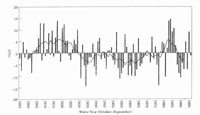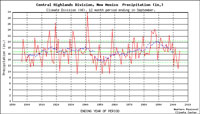OK, that’s an intentionally provocative and more than slightly misleading title. The original and more meaningful title for this was “Climate Variability: Thinking About What Matters,” but is that gonna sell?
I spend time on this blog explaining the science of anthropogenic climate change, and explaining the flaws in some of the more egregiously dishonest attempts to debunk it, which may create some misapprehensions about what I think is important. I was thinking about this recently when, for a project I’m working on, I came across some interesting data about the allocation Colorado River water (click through for more):

That’s from R. S. Pulwarty, T. S. Melis, Journal of Environmental Management 63, 307 (November, 2001), and it shows how the Colorado River’s flows were well above the long term average during the first few decades of the 20th century. That is the period during which the Colorado River Compact was negotiated, allocating the river’s water among the states of the southwestern United States. The allocated more water than they had. (I’ve got some other longer-term data laying around somewhere, based on tree rings – if I can lay my hands on it I’ll post it too. Same basic message – unusually wet when the decisions about distributing Colorado River water were made.)
It’s an example of the same sort of decadal-scale climate variability that’s bitten societies in this region and elsewhere again and again – max out your resources during a wet spell, grow to the boundaries of what’s possible, and you’ll get screwed when it gets dry.
Greenhouse gases could make those decadal-scale swings worse. But things societies can do to reduce their vulnerability to those decadal-scale swings will also reduce their vulnerability to the changes caused by greenhouse gases. Eliminating greenhouse gas emissions, and greenhouse climate change (if that were somehow possible) will not remove the risks of decadal-scale variability.
Here’s similar data for New Mexico’s northern mountains (courtesy Western Regional Climate Center:

(Blue x’s are 10-year moving average.)
It was wet here in the 1980s and ’90s when the region’s population exploded. The extent to which the greenhouse debate has obscured attention to broader issues of societal vulnerability to climate change is a problem.
